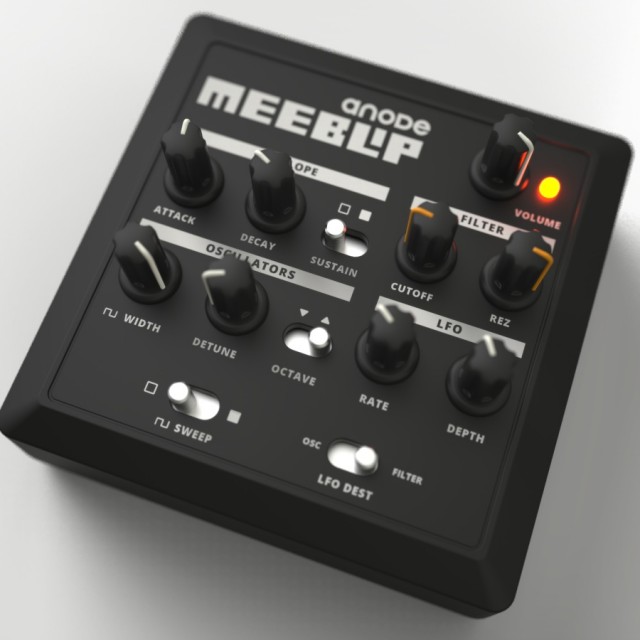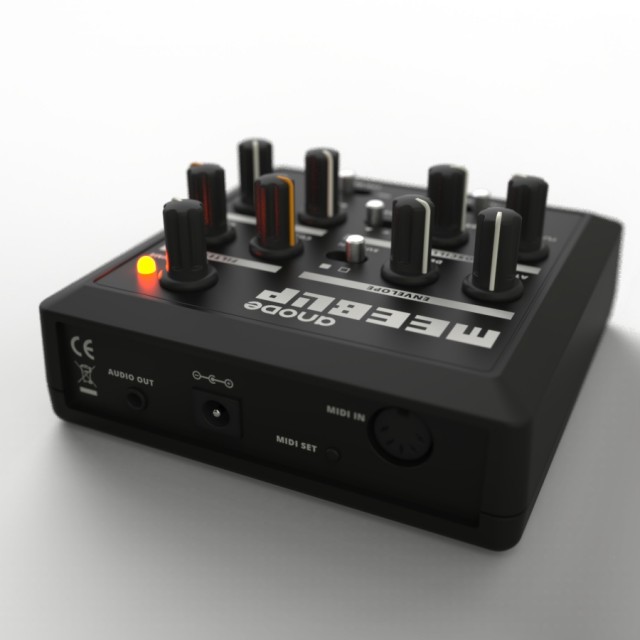Canadian electronics company Blipsonic and Berlin-based website Create Digital Music have introduced their latest joint venture, the MeeBlip anode – a compact bass synth, complete with an analog filter.
The anode is a hybrid analogue/digital instrument, featuring digital pulse oscillators with pulse width control – based on those found in the original MeeBlip – alongside a three-stage envelope, a LFO and an all-analogue filter with resonance control.
As with the original MeeBlip, the anode is open source, and users are encouraged to learn from and experiment with its code and circuits. The anode comes fully pre-assembled, however, and is ready for use straight out the box.
According to its developers, the MeeBlip anode is “capable of producing a range of uniquely aggressive, bass-heavy sounds.”
Does it deliver? Check out these audio demos and let us know what you think:
MeeBlip anode specs:
- 4″x4″ compact case.
- Hands-on control via full-sized knobs and switches.
- Dual digital pulse oscillators, derived from the original MeeBlip.
- An original, all-analog filter with resonance. (It’s a new Twin-T VCF, designed especially to be aggressive for bass sounds.)
- Variable pulse width, plus a pulse width sweep.
- Three-stage envelope controls (Attack knob / Decay knob / Sustain switch).
- Wide detune range for tuning harmonic intervals, plus an octave switch for dropping an oscillator deeper into bass territory
- LFO, tuned for great-sounding results, which can be routed to pitch or filter.
- MIDI input via standard MIDI DIN port.
- MIDI control of all parameters, with the exception of (analog) filter resonance.
- 1/8″ audio output.
- North American or European/UK power adapter included.
- Fully open source hardware, released under a GPLv3 and Creative Commons BY-SA license. Modify the firmware if you choose via the onboard hack port; browse or fork at http://github.com/meeblip
The MeeBlip anode is available to pre-order at a discounted price now, and is due to ship at the start of 2014. The synth is priced at $129.95/129.95 Euro/£109.95. Ordering before 3 Dec using the code THANKSGIVING will gain an additional discount of $20/20Euro/£15.



Samples sound like they have a really high noise floor or something?
sounds okay but at just £10 cheaper than any of the korg volcas…hard to see it sell many…if it was £75 would be more interesting esp. as the oscillators are digital.
With the introductory discount, it’s £95 and includes a power supply. That’s pretty good for a small manufacturer.
You really can’t compare the price a giant manufacturer like Korg, who produces thousands of units and has a gigantic marketing machinery to support sales, with these guys here. I think you people should try to develop a product like this once to know what it means.
I own and love all three volcas; they’re lovely instruments and a terrific value – we’re humbled that anyone is making the comparison.
We think there’s still plenty of room for what we’re doing (and what a number of other builders are doing, too). anode is a very different instrument from the volcas – already excited I get to finally make music with the anode and volcas together.
Digital oscillators lets you do some things analog oscillators don’t. The aliasing on the low end of the anode is part of why we like using it as a bass synth. (It’s anti-aliased for higher ranges, so it’s not *exclusively* a bass synth, but … okay, that is where I have the most fun.) The analog filter is also of a very different design than what’s on the volcas and other recent synths – instead of a transistor/diode ladder design or these MS-inspired filters we’ve heard later, it’s a modified bandpass design. We wanted something that could be a bit more aggressive across its whole range, with and without resonance. We’ll talk about that a bit more, and I hope to get more sound samples up. We also put together a very different workflow that’s built around focusing on just a few full-sized knobs.
To me, looking at the range of instruments available, it’s kind of impressive just how much room there is for new synths, but no one is running out of designs yet. These are all fairly old ideas in synthesis across the whole market, but there are still plenty of combinations to try and new ways to tweak the formula.
They should sell these as kits for a lower price, and quicker turnaround. Then the bang for buck would be awesome and the building process it would give the customer a better insight on potential circuit bending.
Well afaik it’s not really a kit, you don’t have to solder them yourself. Also this is a pre-order, that’s why the delivery takes so long, they are not done with production yet I guess.
We’re definitely working to make things as affordable and fast as possible, and we’ve considered these other options and determined this was the best way to go.
Quicker turnaround – yes, we’re working on that.
As for kits, we can’t make a kit much cheaper than a fully-assembled unit. Since people expect kits to be a lot cheaper, as your comment illustrates, that gets us into some trouble: we make less money that we need to invest in future products, and then we have to support customers putting together the kits. And we think a lot of people want something they can use right away.
For DIYers, we are still working as fast as we can to finish the next-generation MeeBlip micro, a board you can build into your own projects. There, again, we believe we should be fully-assembled. It allows us to test the boards and make sure they work, which we can’t do if customers assemble them. But then, micro owners can make their own hardware/software modifications and spend the time with a soldering iron building new enclosures, input devices, etc.
Some products do work as kits – and some of those are better at illustrating circuit design, are better for teaching soldering to beginners, etc. It really depends on the design.
I do hope some people try putting together our new filter, though, absolutely. We’ll be sure to let everyone know once everything is organized and up on GitHub.
It’s always a matter of taste or personal preferences. As much as people will never stop the almost religious Windows vs OSX discussion, there will always be one half of DIYers and another half of people like me, who just want to buy an instrument and start playing it. It is really not worth dicussing this, because it is a non-issue.
If you want to assemble your own synth, the anode is not for your. It’s as simple as that.
For me, this sounds rather like I would prefer to spend 130 € on this than spending 30 € on a Monotron. Even despite the “lack of” audio input.
Maybe just me, but I’m not sold on anything that has analog filter and no audio input.
“The MeeBlip is open source hardware. Hacking the MeeBlip isn’t just a privilege or a feature; it’s a right.”
audio in is probably a fairly easy hack.
We’d love to do something with input. This just wasn’t the time.
anode is very, very small. It’s 4″ square / 100mm x 100mm, roughly.
I’m kind of of the opinion, too, that something with input ought to be designed around the input. But yes, mods will be possible – and we’re publishing the filter circuit design.
Cool!!
Looks like a tiny waldorf rocket
It would be cool to have paraphony on this, although I guess the little 8 bit AVR might already pushed to the limit.
Does anybody know about that???
Why all the demos (of Meeblip SE also) feature only sustained envelopes, but no plucky bass sounds? I see an envelope generator in the unit but seems like it’s not used. Maybe it can’t get to short decays and punchy envelopes or the designers just don’t like that kind of sounds?
I have the Meeblip SE, and it definitely does nice plucky sounds. You can get a very quick envelope on it.
Is it based on Arduino, Peter? I can’t really mod assembly language, so my Meeblip has stayed firmly stock in terms of software, whereas my Nebulophone has been hacked a lot to make it do what I want to do.
No, it isn’t based on Arduino. MeeBlip does use a related chip as its microcontroller, an AVR. But it is possible to mod. It’s been overdue as our heads have been pretty deep in finishing anode and the new micro, but my goal for early 2014 is to show people how to make mods. It’s really easy, for instance, to decide to remap knobs (like adding Glide), or change the range on a control. We know it isn’t intuitive now, but we’re working on that.
Oh, and also worth saying – someone pointed out to me that you can write and compile the code MeeBlip uses inside the Arduino environment. You won’t be writing Arduino code, but at least the editor will look familiar.